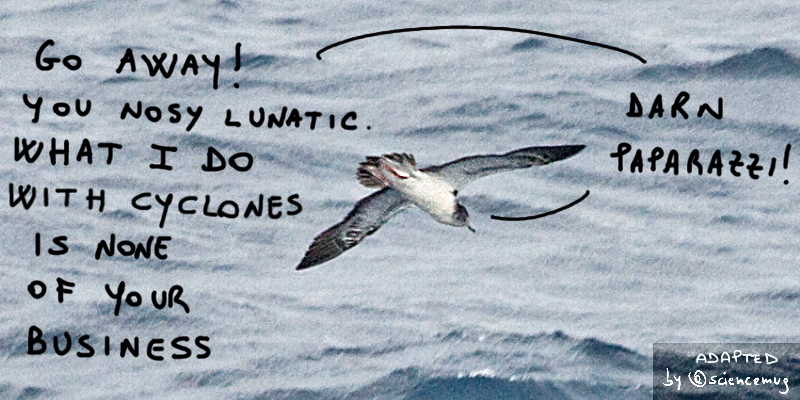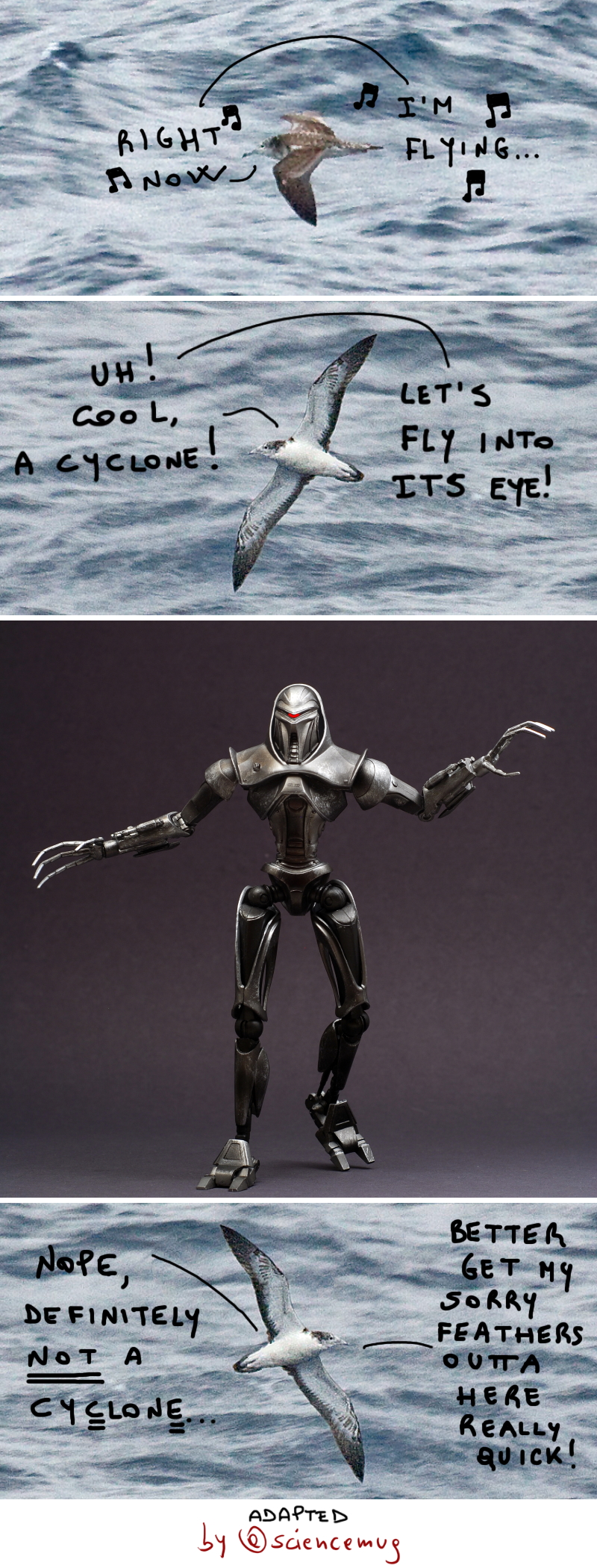 |
| Seabird (streaked shearwater) vs paparazzi (by @sciencemug) Streaked shearwater pic by Tony Morris, is under CC BY-NC 2.0 license (source: flickr); all pics adapted by @sciencemug |
Sooo, pal reader, a bunch of researchers from the UK and Japan use the Global Positioning System (aka GPS) to track, for eleven years, adult streaked shearwaters in the Sea of Japan (Lempidakis et al., 2022 (P)).
Shearwaters are indeed pelagic seabirds,
meaning the kind of winged creatures that live a big chunk of their
lives on open oceans and seas (others are, for instance, albatrosses
and puffins).
Now, dear reader, you're for sure asking yourself why our science people look into these specific birds' movements, and in that particular location?
Well, buddy, it has to do with the fact that the brains are interested in cyclones (aaand, no pal, although they can and do kill humans, cyclones are not a new model of humans-killing machines designed for a reboot of the Battlestar Galactica saga maybe with a less crappy finale than the last one, not that that'd require a big effort, given the high level of crappiness of said finale, by the way)
 |
| Seabird (streaked shearwater) vs cyclone vs cylon (by @sciencemug) Streaked shearwater pic1 & pic2 by Tony Morris, and Cylon pic by GogDog are under CC BY-NC 2.0 license (source: flickr); all pics adapted by @sciencemug |
and in how seabirds react to these billions of bucks atmospheric damage making phenomena that provoke, among all the rest, "mass mortality and strandings" (P) (given that tens of thousands of individuals can be wrecked in the worst cases) in, precisely, seabirds.
Now, as per the location, the Sea of Japan is "the world’s most active cyclone basin" (P), and as per the birds, well, shearwaters breed also there.
Ok reader, so the UK+Japan researchers know, from the few studies available on the subject, that seabirds usually go around or above the higher speed winds of the cyclones, even flying up to 400 – 600 km from their routine foraging area not to meet & greet them. But, after analyzing their collected data, our science dudes find out that shearwaters' "response to cyclones [varies] according to the wind speed and direction. In strong winds, birds that [are] sandwiched between the storm and mainland Japan [fly] away from land and toward the eye of the storm, flying within ≤30 km of the eye" (P).
In other words, dear reader, when between a rock (the cyclone) and a hard place (the land), our mighty shearwaters dive into the former, right toward its eye. Like that, our skilled birds face the strongest winds (with a speed ≤75 km/h), yes, but they manage to avoid the powerful onshore winds and therefore reduce the deadly risk to be pushed toward land and be hit by some flying bullet-like debris, or crash down or, once landed alive, be unable to take-off again and then becoming an easy target for predators like crows and raptors.
Shearwater - that are "relatively small, weighing some 580g, and typically fly with airspeeds up to ~ 14 m/s [~ 50 km/h]" (P) - are able to ride the cyclones that way 'cause they are able to exploit strong winds tanks to "their use of dynamic soaring flight, which enables them to extract energy from the vertical wind gradient and fly at low metabolic cost" (P).
Their storm-facing strategy, however, is linked, as mentioned, to the speed and direction of the winds and the location of the land. Therefore, it seems adult shearwaters probably can count on a "map sense, which would be required for knowledge of the distance and direction to [said] land" (P), and such navigational skill would be the result of a selective pressure. Proof of that would be that juvenile exemplars of shearwater should be less able to successful face cyclones as they lack that map sense, and can just count on their innate compass bearing to migrate. And the fact that young shearwaters "appear to be particularly susceptible to being wrecked after storms [...] [(]although the exact cause of wrecking and/or mortality is unclear[)]" (P) seems to confirm this hypotesis.
Aaaaanyway, dear reader, this dumb blog, in the following cartoon, shows you its idea about the actual reason why our resourceful seabirds, the streaked shearwaters, do their thing into the storms...
 |
| Seabirds (streaked shearwater & albatross) vs cyclone (by @sciencemug) Streaked shearwater pic by Tony Morris, and albatross pic by GRID-Arendal are under CC BY-NC 2.0 license (source: flickr); free storm pic by Daniel Lerman (source: unsplash); all pics adapted by @sciencemug |

No comments:
Post a Comment
Thanks for your comment dear reader!